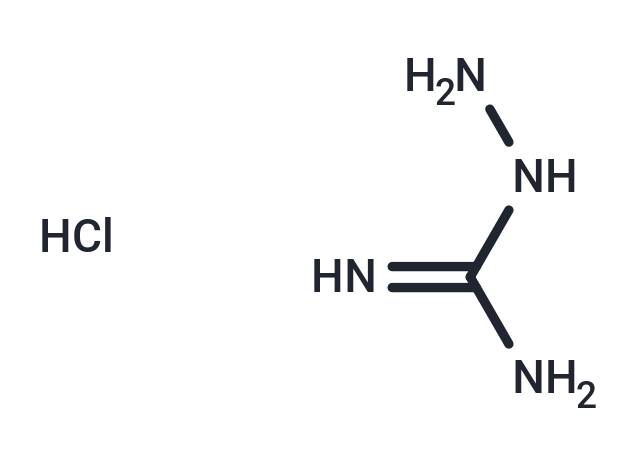Shopping Cart
- Remove All
 Your shopping cart is currently empty
Your shopping cart is currently empty

Aminoguanidine hydrochloride (Hydrazinecarboximidamide) is a diamine oxidase and NO synthase inhibitor, used in the treatment of diabetic nephropathy.

| Pack Size | Price | Availability | Quantity |
|---|---|---|---|
| 50 mg | $36 | In Stock | |
| 100 mg | $50 | In Stock | |
| 200 mg | $75 | In Stock | |
| 500 mg | $119 | In Stock | |
| 1 mL x 10 mM (in DMSO) | $50 | In Stock |
| Description | Aminoguanidine hydrochloride (Hydrazinecarboximidamide) is a diamine oxidase and NO synthase inhibitor, used in the treatment of diabetic nephropathy. |
| In vivo | Aminoguanidine ameliorates neonatal hypoxic-ischemic brain damage and that temporal profiles of NO correlated with the neuroprotective effect of aminoguanidine. Neuroprotection by AG is attributable to suppression of NO produced by iNOS after the end of the hypoxic period, during the reoxygenation phase. The half-life of AG is estimated to be between 6 and 8 h in vivo and approximately 4.4 h in human with normal renal function.AG is also an inhibitor of the formation of advanced glycation end products. Systematically administered advanced glycation end product–modified BSA increases cerebral infarct size in an adult rat, which is attenuated by AG[2]. |
| Alias | Pimagedine hydrochloride, Imino semicarbazide, Hydrazinecarboximidamide, Guanylhydrazine hydrochloride |
| Molecular Weight | 110.55 |
| Formula | CH6N4·HCl |
| Cas No. | 1937-19-5 |
| Smiles | Cl.NNC(N)=N |
| Relative Density. | no data available |
| Storage | Powder: -20°C for 3 years | In solvent: -80°C for 1 year | Shipping with blue ice. | |||||||||||||||||||||||||||||||||||
| Solubility Information | DMSO: 50 mg/mL (452.28 mM), Sonication is recommended. Ethanol: < 1 mg/mL (insoluble or slightly soluble) H2O: 20 mg/mL (180.91 mM), Sonication is recommended. | |||||||||||||||||||||||||||||||||||
Solution Preparation Table | ||||||||||||||||||||||||||||||||||||
H2O/DMSO
| ||||||||||||||||||||||||||||||||||||

Copyright © 2015-2025 TargetMol Chemicals Inc. All Rights Reserved.